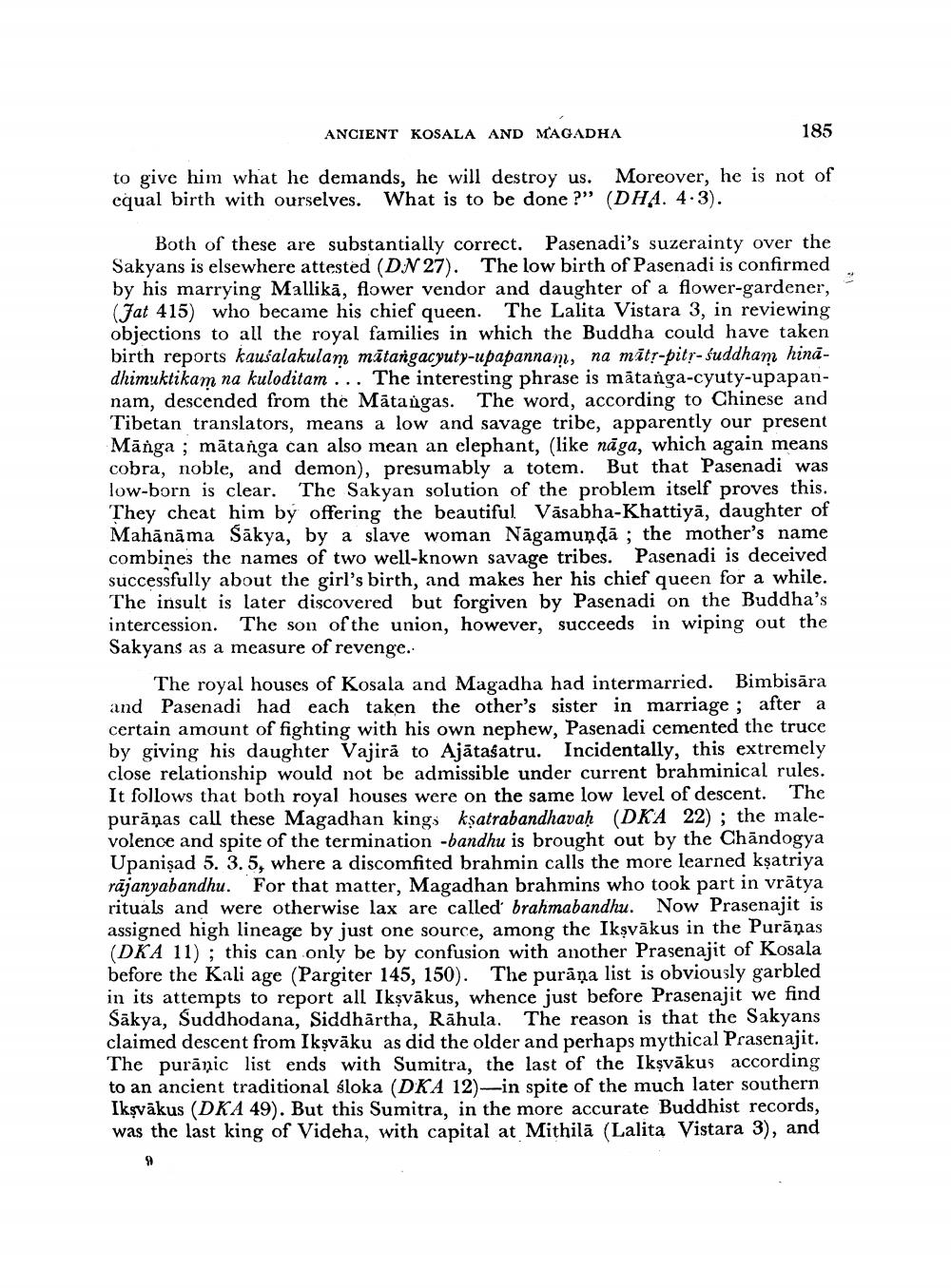Book Title: Ancient Kosala And Mmagadha Author(s): Dharmanand Kosambi Publisher: D D Kosambi View full book textPage 6
________________ ANCIENT KOSALA AND MAGADHA 185 to give him what he demands, he will destroy us. Moreover, he is not of cqual birth with ourselves. What is to be done?” (DHA. 4.3). Both of these are substantially correct. Pasenadi's suzerainty over the Sakyans is elsewhere attested (D:N 27). The low birth of Pasenadi is confirmed by his marrying Mallikā, flower vendor and daughter of a flower-gardener, (Jat 415) who became his chief queen. The Lalita Vistara 3, in reviewing objections to all the royal families in which the Buddha could have taken birth reports kaušalakulam matangacyuty-upapannam, na mītr-pitr-śuddham hinadhimuktikam na kuloditam ... The interesting phrase is mātanga-cyuty-upapannam, descended from the Mātangas. The word, according to Chinese and Tibetan translators, means a low and savage tribe, apparently our present Mānga ; mātanga can also mean an elephant, (like nāga, which again means cobra, noble, and demon), presumably a totem. But that Pasenadi was low-born is clear. The Sakyan solution of the problem itself proves this. They cheat him by offering the beautiful Väsabha-Khattiyā, daughter of Mahānāma Sākya, by a slave woman Nāgamundā; the mother's name combines the names of two well-known savage tribes. Pasenadi is deceived successfully about the girl's birth, and makes her his chief queen for a while. The insult is later discovered but forgiven by Pasenadi on the Buddha's intercession. The son of the union, however, succeeds in wiping out the Sakyans as a measure of revenge. The royal houses of Kosala and Magadha had intermarried. Bimbisāra and Pasenadi had each taken the other's sister in marriage ; after a certain amount of fighting with his own nephew, Pasenadi cemented the truce by giving his daughter Vajira to Ajātaśatru. Incidentally, this extremely close relationship would not be admissible under current brahminical rules. It follows that both royal houses were on the same low level of descent. The purāņas call these Magadhan king, ksatrabandhavaḥ (DKA 22); the malevolence and spite of the termination -bandhu is brought out by the Chăndogya Upanişad 5, 3.5, where a discomfited brahmin calls the more learned ksatriya rājanyabandhu. For that matter, Magadhan brahmins who took part in vrätya rituals and were otherwise lax are called brahmabandhu. Now Prasenajit is assigned high lineage by just one source, among the Ikşvākus in the Purānas (DKA 11); this can only be by confusion with another Prasenajit of Kosala before the Kali age (Pargiter 145, 150). The purāna list is obviously garbled in its attempts to report all Ikşvākus, whence just before Prasenajit we find Sākya, Suddhodana, Siddhartha, Rāhula. The reason is that the Sakyans claimed descent from Ikşvāku as did the older and perhaps mythical Prasenajit. The purānic list ends with Sumitra, the last of the Ikşvākus according to an ancient traditional sloka (DKA 12)-in spite of the much later southern Ikşvākus (DKA 49). But this Sumitra, in the more accurate Buddhist records, was the last king of Videha, with capital at Mithilā (Lalita Vistara 3), andPage Navigation
1 ... 4 5 6 7 8 9 10 11 12 13 14 15 16 17 18 19 20 21 22 23 24 25 26 27 28 29 30 31 32 33 34
